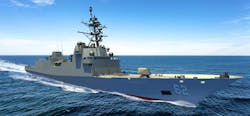Navy orders fourth Constellation-class frigate for anti-air missile and anti-submarine warfare (ASW)
WASHINGTON – The U.S. Navy placed an order last week to build the fourth Constellation-class guided-missile frigate for independent blue-water operations, or to escort carrier battle groups or surface action task forces.
Officials of the Naval Sea Systems Command in Washington announced a $526.3 million order on 18 May to Fincantieri Marinette Marine Corp. in Marinette, Wis., to build the yet-unnamed FFG 65 Constellation-class frigate.
This ship will be the fourth in a class of at least 20 frigates. The hull of the vessel will be based on the Italian FREMM-class frigate. The first three ships of the class also are under contract to Fincantieri Marinette Marine.
The Constellation-class frigate will be able to keep up with Navy aircraft carriers and will have sensors networked with the rest of the fleet. It normally will be part of Navy strike groups and large surface combatant-led surface action groups, but also will be able to operate and defend itself while working alone.
Frigates typically are escort vessels that are lighter than destroyers, and help defend aircraft carrier battle groups or merchant convoys from submarines, aircraft, and cruise missiles. They are intended to operate in the open ocean, unlike the Navy littoral combat ship, which is designed to operate in coastal waters and harbors.
The new frigates will have a minimum of 32 Mark 41 Vertical Launch System cells aboard for anti-air warfare. The ship will be designed to destroy surface ships over the horizon; detect enemy submarines; defend convoy ships; employ active and passive electronic warfare systems; and defend against swarming small boat attacks.
Shipboard electronics will include the Lockheed Martin COMBATSS-21 combat management system; AN/SPY-6(V)3 Enterprise Air Surveillance Radar (EASR); AN/SPS-73(V)18 surface search radar; AN/SLQ-61 lightweight towed array sonar; AN/SQS-62 variable-depth sonar; AN/SQQ-89F undersea warfare and anti-submarine warfare (ASW) combat system; and Cooperative Engagement Capability (CEC).
The Constellation-class frigate will be able to fire RIM-162 ESSM Block 2 and/or RIM-174 Standard ERAM missiles; RIM-66 Standard SM-2 Block 3C; the Naval Strike Missile; RIM-116 Rolling Airframe Missile; Mk 110 57-millimeter gun; and machine guns. The ship will be able to carry one MH-60R Seahawk helicopter and the MQ-8C Firescout unmanned helicopter.
Related: A once-proud class of U.S. Navy surface warships is quickly fading away
The Constellation and its first two sister ships, the USS Congress (FFG 63) and USS Chesapeake (FFG 64) are named for three of the Navy's six original frigates -- USS Chesapeake; USS Constitution; USS President; USS United States; USS Congress; and USS Constellation -- built between 1797 and 1800.
Of these original ships, the USS Constitution still is a Navy commissioned warship and is based in Boston. It is likely this fourth ship of the class will be named USS President or USS United States.
On this order Marinette Marine will do the work in Marinette, Green Bay, Sturgeon Bay, and Kaukauna, Wis.; Camden, N.J.; Chicago; Pittsburgh; Hauppauge, N.Y.; Cincinnati; Charlotte, N.C.; Bethesda and Millersville, Md.; and Atlanta, and should be finished by December 2028.
